Submitted:
26 December 2023
Posted:
26 December 2023
You are already at the latest version
Abstract
Keywords:
1. Introduction
2. Development of CZT material
2.1. The basic structure and advantages of CZT material
2.2. Preparation of CZT materials
2.2.1. The evolution of the way CZT grows
| Preparation Method | Advantages | Disadvantages |
| BV | Simple structure and ease of operation for producing uniform CZT crystals; various Bridgman method variations available as per requirement. | Potential issues of crystal cracking and occurrences of polycrystalline and twinning phenomena. |
| HPB | Provides a high crystal growth rate by using high-pressure inert gas to prevent element evaporation | May still encounter crystal cracking and potential polycrystalline and twinning issues. |
| MVB | Enhanced CZT crystal quality using improved techniques; production of relatively large CZT crystals | Possibility of twinning and grain boundary problems. |
| HB | Achieves a uniform matrix during growth, improving yield and cost-effectiveness | might result in lower volume resistivity, potentially affecting energy resolution; not suitable for detecting lower energy radiation. |
| THM | Enables continuous crystal growth, resulting in CZT crystals with higher uniformity and lower defect density. | Slower crystal growth rates, significant temperature gradients during preparation, which can lead to temperature fluctuations and uneven solute distribution. |
2.2.2. Doping and performance changes of CZT
2.2.3. Semiconductor surface treatment technology
2.3. Research on the properties of CZT materials
2.3.1. Reaction of γ rays with CZT material
2.3.2. Research on the energy resolution of CZT materials
2.3.3. Research on the energy bands of CZT crystals
| Empirical formula | Research Group | Temperature |
| Eg (eV)=1.604+0.42x+0.33x2 | Taguchi | 9K |
| Eg (eV)=1.5964+0.445x+0.33x2 | Doty | 12 K |
| Eg (eV)=1.586+0.5006x+0.29692x2 | 77 K | |
| Eg (eV)=1.4637+0.496x+0.2289x2 | 300 K | |
| Eg (eV)=1.598+0.614x-0.116x2 | Polichar | |
| Eg (eV)=1.5+0.5x+0.2x2 | Toney | |
| Eg (eV)=1.5045+0.631x+0.128x2 | Tobin | |
| Eg (eV)=1.606+0.332x+0.462x2 | Hoschl | |
| Eg (eV)=(1.494±0.005)+(0.606±0.010)x+(0.139±0.010)x2 | Li |
3. Development of CZT array detectors
3.1. Different structured CZT detector
3.1.1. CZT detector structure
3.1.2. Operating principle of the CZT array detector
3.2. Research on the performance optimization of CZT array detectors
3.2.1. Optimization of energy resolution
- Impact of leakage current: In CZT devices with Au and Pt contacts, the overall leakage current is restricted by the characteristics of the Schottky barrier at the metal-semiconductor interface.
- Influence of charge sharing among pixels: Inter-pixel electric conduction affects the distribution of electric field lines, leading to charge loss between adjacent anode contacts in multi-electrode devices.
- Effects of charge loss: Charge loss usually accompanies charge sharing. Some electrons in the electron cloud between pixels fall into the gap and remain uncollected by the pixel electrodes, resulting in charge loss.
3.2.2. Research on the spatial resolution of array detectors
3.2.3. Optimization of detection efficiency
3.3. Array Detector Electronics
3.3.1. CZT crystal contact electrode
3.3.2. Readout circuitry
3.3.3. Charge Sensitive Preamplifier
3.3.4. Research in signal processing
4. Application of CZT array detector in nuclear detection and imaging
4.1. Application of CZT detector in nuclear detection
4.2. Research on the application of Compton imaging and positioning
4.2.1. Principle of image formation
4.2.2. Developments in imaging technology
- Power Supply Output: Provision of DC power configuration to the ASIC module as required; Supply of the necessary high voltage power to the cadmium zinc telluride detector.
- Data Communication: Response to control and configuration commands from the PC; Transmission of the current system status and acquired data to the PC.
- ASIC Configuration: Configuration of 650 internal registers within the ASIC module based on configuration commands from the PC.
- Trigger Threshold Setting: Adjustment of the trigger voltage of the ASIC module according to configuration commands from the PC.
- Conditioning and Digitization of Energy and Time Signals: Energy information output by the ASIC module in the form of differential current signals necessitates analog conditioning to convert it into voltage signals before analog-to-digital conversion. Time information from the ASIC module is in the form of voltage signals, requiring initial driving before analog-to-digital conversion.
- Readout Timing Control: Control of the ASIC module for data readout according to the corresponding timing circuits.
- Self-Testing Functionality: Testing the status of the Ethernet connection.
- Configuration and monitoring of the current operational status of the data acquisition board;
- Real-time visualization of collected data for quick diagnosis of the detector's operational status;
- Capability to save the collected data.
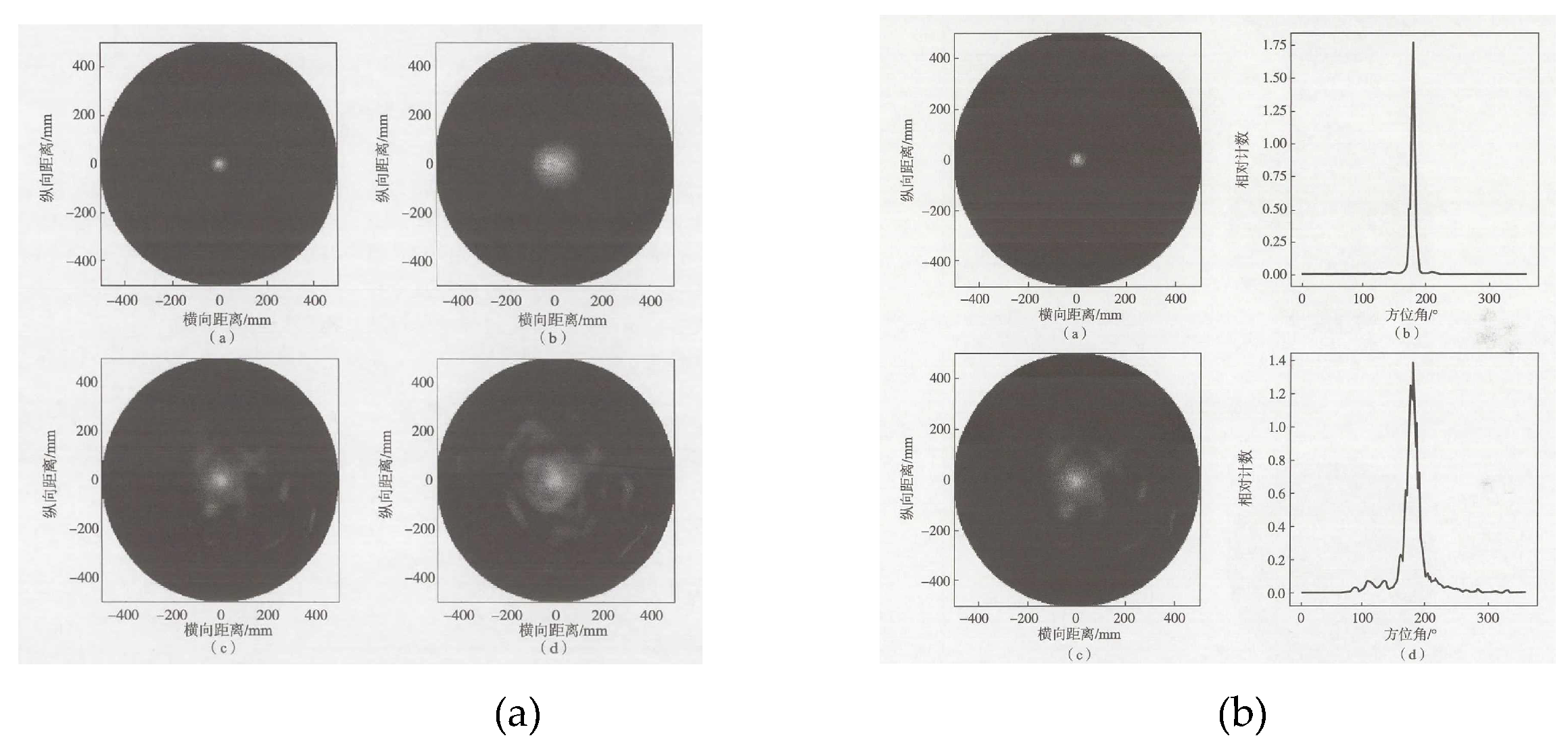
5. Conclusions
- CZT Crystal Research: Enhancing crystal performance by improving semiconductor crystal fabrication methods, doping with trace elements, refining etching processes, or applying surface coatings.
- Optimization of Array Detector Electronics: Improving detector readout circuit design, enhancing the performance of electronic components, and increasing detector response speed and energy resolution.
- Design of Novel CZT Array Detectors: Developing and optimizing applications for CZT array detectors, especially in the detection of specific nuclear materials.
- Enhancement of Array Detector Imaging Algorithms: Improving imaging algorithms to achieve better reconstruction results and generate improved 3D images.
References
- Arlt, R.; Brutscher, J.; Gunnink, R.; Ivanov, V.; Parnham, K.; Soldner, S.; Stein, J. Use of CdZnTe detectors in hand-held and portable isotope identifiers to detect illicit trafficking of nuclear material and radioactive sources. In Proceedings of the 2000 IEEE Nuclear Science Symposium. Conference Record (Cat. No. 00CH37149), 2000; pp. 4/18-14/23 vol. 11.
- Sordo, S.D.; Abbene, L.; Caroli, E.; Mancini, A.M.; Zappettini, A.; Ubertini, P. Progress in the Development of CdTe and CdZnTe Semiconductor Radiation Detectors for Astrophysical and Medical Applications. Sensors (Basel) 2009, 9, 3491–3526. [Google Scholar] [CrossRef]
- Liu, L. The photoelectrical properties of CdZnTe nuclear radiation detector. Xiamen University of Technology, 2022.
- Szeles, C. CdZnTe and CdTe materials for X-ray and gamma ray radiation detector applications. physica status solidi (b) 2004, 241, 783–790. [Google Scholar] [CrossRef]
- Li, X.; Chu, J.H.; Li, L.X.; Dai, N.; Zhang, F.J. Investigation of room temperature nuclear radiation CdZnTe pixel array detector. Journal of Optoelectronics Laser 2008, 19, 751–753. [Google Scholar]
- Handong, L. Growth and Defects of CdxZn1-xTe Single Crystals. Sichuan University, 2004.
- LYU, L.; Liu, J.; LI, G. Research on High-Precision mm-Level Thickness Measurement Technology Based on Cadmium Zinc Telluride Detector. Journal of Isotopes 2023, 36, 285–294. [Google Scholar] [CrossRef]
- Hongzhao, Z.; Mingzhe, S.; Haixia, L. Simulating Response to Gamma Ray of CdZnTe Detector with CAPture Electrode Using Geant4. Atomic Energy Science and Technology 2021, 55, 1098–1104. [Google Scholar]
- Eisen, Y. Current state-of-the-art industrial and research applications using room-temperature CdTe and CdZnTe solid state detectors. Nuclear Instruments and Methods in Physics Research Section A: Accelerators, Spectrometers, Detectors and Associated Equipment 1996, 380, 431–439. [Google Scholar] [CrossRef]
- Lihao, W. Study on the pivotal techniques of gamma spectrum measurement in complex intense radiation field. National University of Defense Technology, 2021.
- Haijun, X. Data Acquisition System of CZT Nuclear Detector Based on FPGA. Chongqing University, 2013.
- Burger, A.; Groza, M.; Cui, Y.L.; Roy, U.N.; Hillman, D.; Guo, M.; Li, L.X.; Wright, G.W.; James, R.B. Development of portable CdZnTe spectrometers for remote sensing of signatures from nuclear materials. In Proceedings of the NATO Advanced Research Workshop on Advanced Materials for Radiation Detectors and Sensors/Symposium on Superconductors held at the 2004 E-MRS Fall Meeting, Warsaw, POLAND, 2005, Sep 06-10, 2004; pp. 1586-1591.
- Fan, Y.; Tao, W.; Boru, Z. Research Progress on CdZnTe Crystal Growth for Room Temperature Radiation Detection Applications. Journal of Synthetic Crystals 2020, 49, 561–569. [Google Scholar]
- Wanqi, J. Progress of Bridgman Crystal Growth Technology. Journal of Synthetic Crystals 2012, 24–35. [Google Scholar]
- Doty, F.; Butler, J.; Schetzina, J.; Bowers, K. Properties of CdZnTe crystals grown by a high pressure Bridgman method. Journal of Vacuum Science & Technology B: Microelectronics and Nanometer Structures Processing, Measurement, and Phenomena 1992, 10, 1418–1422. [Google Scholar]
- Szeles, C. Advances in the crystal growth and device fabrication technology of CdZnTe room temperature radiation detectors. IEEE Transactions on Nuclear Science 2004, 51, 1242–1249. [Google Scholar] [CrossRef]
- Szeles, C.; Cameron, S.E.; Ndap, J.O.; Chalmers, W.C. Advances in the crystal growth of semi-insulating CdZnTe for radiation detector applications. IEEE Transactions on Nuclear Science 2002, 49, 2535–2540. [Google Scholar] [CrossRef]
- Szeles, C.; Cameron, S.E.; Ndap, J.O.; Reed, M.D. Advances in the High-pressure Crystal Growth Technology of Semi-insulating CdZnTe for Radiation Detector Applications. Proceedings of SPIE - The International Society for Optical Engineering 2004, 5198. [Google Scholar]
- Szeles, C.; Cameron, S.E.; Soldner, S.A.; Ndap, J.O.; Reed, M.D. Development of the high-pressure electro-dynamic gradient crystal-growth technology for semi-insulating CdZnTe growth for radiation detector applications. Journal of Electronic Materials 2004, 33, 742–751. [Google Scholar] [CrossRef]
- Li, L.; Lu, F.; Lee, C.; Black, M.; Ouimette, D. New progress in large-size CZT (Zn=10%) single crystal growth using MVB technique for room temperature radiation detectors. IEEE 2004. [Google Scholar]
- Wang, T.; Jie, W.; Xu, Y.; Liu, W.; Zeng, D. Comparison between bottom-seeded Bridgman and accelerated crucible rotation Bridgman method for detector-grade CdZnTe growth. In Proceedings of the 2007 International Conference on Solid State Devices and Materials; 2007. [Google Scholar]
- Gangqiang, Z.; Tao, W.; Yadong, X. The development of CZT semiconductor X-ray and g-ray detectors. Physics 2013, 42, 862–869. [Google Scholar]
- Tao, W.; Yadong, X.; Gangqiang, Z. Detector Grade CdZnTe Crystal Growth and Device Fabrication. Mechanical Science and Technology for Aerospace Engineering 2010, 29, 546–550. [Google Scholar]
- Yang, F.; Jie, W.; Wang, M.; Sun, X.; Wang, T. Growth of Single-crystal Cd0.9Zn0.1Te Ingots using Pressure Controlled Bridgman Method. Crystals 2020, 10, 261. [Google Scholar] [CrossRef]
- Hermon, H.; Schieber, M.; Goorsky, M.; Lam, T.; Meerson, E.; Yao, H.; Erickson, J.; James, R.B. Characterization of CZT detectors grown from horizontal and vertical Bridgman. Proc Spie 2000, 186–193. [Google Scholar]
- A, I.J.; A, H.K.; B, A.B.; B, M.G.; B, M.G. Detailed studies of pixelated CZT detectors grown with the modified horizontal Bridgman method - ScienceDirect. Astroparticle Physics 2007, 28, 397–408. [Google Scholar]
- Wilson, M.D.; Cernik, R.; Chen, H.; Hansson, C.; Iniewski, K.; Jones, L.L.; Seller, P.; Veale, M.C. Small pixel CZT detector for hard X-ray spectroscopy. Nuclear Instruments and Methods in Physics Research Section A: Accelerators, Spectrometers, Detectors and Associated Equipment 2011, 652, 158–161. [Google Scholar] [CrossRef]
- Xi, C.; Tao, W.; Boru, Z.; Jie, H.; Yang, L.; Fan, Y.; Yadong, X.; Cangqiang, Z.; Wanqi, J. Study on Composition and Defects Uniformity of CdZnTe Crystal Grown by Travelling Heater Method. Journal of Synthetic Crystals 2013, 42, 2215–2229. [Google Scholar]
- Soldner, S.A.; Narvett, A.J.; Covalt, D.E.; Szeles, C. Characterization of the charge transport uniformity of CdZnTe crystals for large-volume nuclear detector applications. Ieee Transactions on Nuclear Science 2004, 51, 2443–2447. [Google Scholar] [CrossRef]
- Mackenzie, J.; Chen, H.; Awadalla, S.A.; Marthandam, P.; Redden, R.; Bindley, G.; He, Z.; Black, D.R.; Duff, M.; Amman, M. recent advances in thm czt for nuclear radiation detection introduction.
- Changhe, Z. Study on defect evaluation and VGF growth technique of CdZnTe materials. University of Chinese Academy of Sciences, 2021.
- Chu, M.; Terterian, S.; Ting, D.; Wang, C.; Benson, J.; Dinan, J.; James, R.; Burger, A. Effects of excess tellurium on the properties of CdZnTe radiation detectors. Journal of electronic materials 2003, 32, 778–782. [Google Scholar] [CrossRef]
- Nan, R.-h.; Jie, W.-q.; Zha, G.-q.; BAI, X.-x.; Bei, W.; Hui, Y. Determination of trap levels in CZT: In by thermally stimulated current spectroscopy. Transactions of Nonferrous Metals Society of China 2012, 22, s148–s152. [Google Scholar] [CrossRef]
- Roy, U.N.; Bolotnikov, A.E.; Camarda, G.S.; Cui, Y.; Hossain, A.; Lee, K.; Lee, W.; Tappero, R.; Yang, G.; Gul, R.; et al. High compositional homogeneity of CdTexSe1-x crystals grown by the Bridgman method. Apl Materials 2015, 3. [Google Scholar] [CrossRef]
- Roy, U.N.; Camarda, G.S.; Cui, Y.; Gul, R.; Yang, G.; Zazvorka, J.; Dedic, V.; Franc, J.; James, R.B. Evaluation of CdZnTeSe as a high-quality gamma-ray spectroscopic material with better compositional homogeneity and reduced defects. Sci Rep 2019, 9, 7303. [Google Scholar] [CrossRef] [PubMed]
- Roy, U.N.; Bolotnikov, A.E.; Camarda, G.S.; Cui, Y.; Hossain, A.; Lee, K.; Marshall, M.; Yang, G.; James, R.B. Growth of CdTexSe1-x from a Te-rich solution for applications in radiation detection. Journal of Crystal Growth 2014, 386, 43–46. [Google Scholar] [CrossRef]
- Nan, R.; Li, T.; Xu, G.; Jian, Z.; Li, X. Distribution of microscopic defects in Al-doped CdZnTe crystal. Journal of Materials Science 2017, 53, 4387–4394. [Google Scholar] [CrossRef]
- Yuan, W.; Zhang, C.; Liang, H.; Wang, X.; Shangguan, M.; Gong, Y.; Zhang, B.; Zhang, H.; Xie, H.; Yan, B. Investigating the influence of CdZnTe and HgCdTe material quality on detector image performance. Journal of Materials Science: Materials in Electronics 2021, 32, 13177–13186. [Google Scholar] [CrossRef]
- Chen, H.; Chattopadhyay, K.; Chen, K.-T.; Burger, A.; George, M.; Gregory, J.; Nag, P.; Weimer, J.; James, R. Passivation of CdZnTe surfaces by oxidation in low energy atomic oxygen. Journal of Vacuum Science & Technology A: Vacuum, Surfaces, and Films 1999, 17, 97–101. [Google Scholar]
- Dongmin, Z.; Shifu, Z.; Beijum, Z.; Deyou, G.; Jun, C.; Shihong, T.; Jun, F.; Xi, C. Surface Passivation Process of the Wafers for CdZnTe Detector. Journal of Synthetic Crystals 2006, 35, 715–718. [Google Scholar]
- Yubao, S.; Li, F.; Jie, R.; Gangqiang, C. Atomic oxygen exposure process on CdZnTe pixel detector suface. Journal of Functional Materials and Devices 2010, 16, 515–518. [Google Scholar]
- Hossain, A.; Bolotnikov, A.; Camarda, G.; Cui, Y.; Jones, D.; Hall, J.; Kim, K.; Mwathi, J.; Tong, X.; Yang, G. Novel approach to surface processing for improving the efficiency of CdZnTe detectors. Journal of electronic materials 2014, 43, 2771–2777. [Google Scholar] [CrossRef]
- Congfeng, L.; Shiwen, S.; Hualian, X. Effect of ampoule coating technology on defects in CdZnTe crystal. In Proceedings of the Photonics and optoelectronics Meetings; 2009. [Google Scholar]
- Lezhen, Z.; Zhenyu, Z.; Dong, W.; Guanghong, X.; Peili, G.; Fanning, M.; Zifeng, Z. CMP Parameter Optimization and Polishing Mechanism Analysis of Cadmium Zinc Telluride Wafer Based on the Orthogonal Test. Lubrication Engineering 2022, 47, 92–101. [Google Scholar]
- Peli, G. Preparation of Novel Abrasives and their applications in Chemical Mechanical Polishing for Cadmium Zinc Telluride Substrates. 2021. [Google Scholar] [CrossRef]
- Jian, J. Study of CdZnTe Pixel Arrays Nuclear Detector. Chongqing University, 2012.
- Mayer, M.; Hamel, L.A.; Tousignant, O.; Macri, J.R.; Ryan, J.M.; Mcconnell, M.L.; Jordanov, V.T.; Butler, J.F.; Lingren, C.L. Signal formation in a CdZnTe imaging detector with coplanar pixel and control electrodes. Nuclear Instruments & Methods in Physics Research 1999, 422, 190–194. [Google Scholar]
- Beilicke, M.; De Geronimo, G.; Dowkontt, P.; Garson, A.; Guo, Q.; Lee, K.; Martin, J.; Krawczynski, H. Performance of pixelated CZT detectors as a function of pixel and steering grid layout. Nuclear Instruments and Methods in Physics Research Section A: Accelerators, Spectrometers, Detectors and Associated Equipment 2013, 708, 88–100. [Google Scholar] [CrossRef]
- Abbene, L.; Del Sordo, S.; Caroli, E.; Gerardi, G.; Raso, G.; Caccia, S.; Bertuccio, G. Hard x-ray response of pixellated CdZnTe detectors. Journal of Applied Physics 2009, 105. [Google Scholar] [CrossRef]
- Xi, W.; Shali, X.; Miao, L.; Liuqian, Z.; Yulin, C.; Yuxiao, C. Further polarization effect of CdZnTe detectors under high flux X-ray irradiation. High Power Laser and Particle Beams 2013, 25, 773–777. [Google Scholar]
- Teague, L.C.; Washington, A.L.; Duff, M.C.; Groza, M.; Buliga, V.; Burger, A. Photo-induced currents in CdZnTe crystals as a function of illumination wavelength. Journal of Physics D-Applied Physics 2012, 45. [Google Scholar] [CrossRef]
- Dědič, V.; Franc, J.; Rejhon, M.; Grill, R.; Zázvorka, J.; Sellin, P. De-polarization of a CdZnTe radiation detector by pulsed infrared light. Applied Physics Letters 2015, 107. [Google Scholar] [CrossRef]
- Wangerin, K.; Du, Y.F.; Jansen, F. CZT performance for different anode pixel geometries and data corrections. Nuclear Instruments & Methods in Physics Research Section a-Accelerators Spectrometers Detectors and Associated Equipment 2011, 648, S37–S41. [Google Scholar] [CrossRef]
- Takahashi, T.; Watanabe, S. Recent progress in CdTe and CdZnTe detectors. IEEE Transactions on nuclear science 2001, 48, 950–959. [Google Scholar] [CrossRef]
- Bolotnikov, A.E.; Camarda, G.S.; Cui, Y.; Hossain, A.; Yang, G.; Yao, H.W.; James, R.B. Internal Electric-Field-Lines Distribution in CdZnTe Detectors Measured Using X-Ray Mapping. IEEE Transactions on Nuclear Science 2009, 56, 791–794. [Google Scholar] [CrossRef]
- Huichao, X.; Peirong, G. Analysis of Noise and Resolution of Prototype CdZnTe Detector. Nuclear Electronics & Detection Technology 2014, 34, 784–787. [Google Scholar]
- Bolotnikov, A.E.; Camarda, G.S.; Cui, Y.; Yang, G.; Hossain, A.; Kim, K.; James, R.B. Characterization and evaluation of extended defects in CZT crystals for gamma-ray detectors. Journal of Crystal Growth 2013, 379, 46–56. [Google Scholar] [CrossRef]
- Chuang, W.; Gangqiang, Z.; Yang, Q.; Rongrong, G.; Guangqi, W.; Wanqi, J. Fabrication and Characterization of CdZnTe Pixel Detector. Atomic Energy Science and Technology 2015, 49, 1320–1324. [Google Scholar]
- Lei, F.; Liangzhou, Z.; Xianglei, C.; Jie, W.; Yulin, Z. Study on Neutron Detection Performance of CdZnTe Detector. Nuclear Electronics & Detection Technology 2019, 39, 463–467. [Google Scholar]
- Yan, X.; Gao, X.; Sun, H.; Yang, D.; Zeng, T.; Luo, X.; Zhu, X.; Wangyang, P. Effect of surface treatment on photo-electric properties of CZT thick film for radiation detector. Materials science in semiconductor processing 2022, 148. [Google Scholar] [CrossRef]
- Min, S.; Shali, X.; Liuqiang, Z.; Yulin, C.; Yuxiao, C. Experiment and simulation of performance characteristics for pixellated CdZnTe detectors with various thickness. High Power Laser and Particle Beams 2014, 26, 210–215. [Google Scholar]
- Hui, Y.; Mengmeng, Z.; Yuanyuan, D.; Shouzhi, X.; Gangqiang, Z.; Wanqi, J. Analysis on Energy Spectra for CdZnTe Gamma Ray Detector. Journal of Synthetic Crystals 2021, 50, 1883–1891. [Google Scholar]
- Wanqi, J. Researches on the Preparation and Applications of CZT for X-ray and Gamma-ray Detectors. Materials China 2012, 815–823. [Google Scholar]
- Wanqi, J. Progress in Theories and Technologies of Crystal Growth of Ⅱ-Ⅵ Compounds. China Basic Science 2001, 15–19. [Google Scholar]
- Glasser, F.; Gerbe, V.; Ouvrier-Buffet, P.; Accensi, M.; Girard, J.; Renaud, M.; Gersten-Mayer, J. CdZnTe high-energy radiography detector. Nuclear Instruments and Methods in Physics Research Section A: Accelerators, Spectrometers, Detectors and Associated Equipment 2001, 458, 544–550. [Google Scholar] [CrossRef]
- Höschl, P.; Ivanov, Y.M.; Belas, E.; Franc, J.; Toth, A.L. Electrical and luminescence properties of (CdZn)Te single crystals prepared by the vertical gradient freezing method. Journal of Crystal Growth 1998, s 184–185, 1039-1043.
- J.E; Toney; and; B.A; Brunett; and; T.E; Schlesinger; and; J.M. Uniformity of Cd1 − xZnxTe grown by high-pressure Bridgman. Nuclear Instruments & Methods in Physics Research 1996.
- Li, Z.-F.; Lu, W.; Huang, G.; Yang, J.; He, L.; Shen, S. Microphotoluminescence mapping on CdZnTe: Zn distribution. Journal of Applied Physics 2001, 90, 260–264. [Google Scholar] [CrossRef]
- Polichar, R.; Schirato, R.; Reed, J. Development of CdZnTe energy selective arrays for industrial and medical radiation imaging. Nuclear Instruments and Methods in Physics Research Section A Accelerators Spectrometers Detectors and Associated Equipment 1994, 353, 349–355. [Google Scholar] [CrossRef]
- Tobin, S.; Tower, J.; Norton, P.; Chandler-Horowitz, D.; Amirtharaj, P.M.; Lopes, V.; Duncan, W.; Syllaios, A.; Ard, C.; Giles, N. A comparison of techniques for nondestructive composition measurements in CdZnTe substrates. Journal of electronic materials 1995, 24, 697–705. [Google Scholar] [CrossRef]
- Y. ; F.; Chen; C.; S.; Tsai; Y.; H.; Chang; Y. Hydrogen passivation in Cd1xZnxTe studied by photoluminescence. Applied Physics Letters 1991, 58, 493–493. [Google Scholar] [CrossRef]
- Xi, W. Principle and Experimental Characteristics of Pixellated CdZnTe Detector for Nuclear Radiation. Chongqing University, 2013.
- Krsmanovic, N.; Lynn, K.G.; Weber, M.H.; Tjossem, R.; Glass, H.L. Electrical compensation in CdTe and CdZnTe by intrinsic defects. Phys.rev.b 2000, 4141. [Google Scholar]
- Guo, R.; Jie, W.; Xu, Y.; Zha, G.; Wang, T.; Lin, Y.; Zhang, M.; Du, Z. Space-charge manipulation under sub-bandgap illumination in detector-grade CdZnTe. Journal of Electronic Materials 2015, 44, 3229–3235. [Google Scholar] [CrossRef]
- Xiang, C.; Kan, Z.; Shuai, H.; Kai, Z.; Hetong, H.; Long, H. Improvement on γ-ray Sensitivity of Current-mode CdZnTe Detector. Atomic Energy Science and Technology 2022, 56, 387–393. [Google Scholar]
- Yaxu, G. Performance non-uniformity of CdZnTe nuclear radiation detectors. Northwestern Polytechnical University, 2017.
- Xiaping, C. Research and Fabrication of 4H-SiC Ultraviolet p-i-n Photodiodes and Linear Array. Xiamen University, 2007.
- Abbene, L.; Del Sordo, S.; Fauci, F.; Gerardi, G.; La Manna, A.; Raso, G.; Cola, A.; Perillo, E.; Raulo, A.; Gostilo, V.; et al. Spectroscopic response of a CdZnTe multiple electrode detector. Nuclear Instruments and Methods in Physics Research Section A: Accelerators, Spectrometers, Detectors and Associated Equipment 2007, 583, 324–331. [Google Scholar] [CrossRef]
- Chengjie, F. Performance comparison of CdZnTe radiation detectors with PIN and MSM structure and the Study on leakage current of CdZnTe. SHANGHAI UNIVERSITY, 2022.
- Mitra; P. Current to Conductors Induced by a Moving Point Charge. American Journal of Physics 1970, 38, 112–112. [Google Scholar] [CrossRef]
- Ramot, S.R.E. currents induced by electron motion*. [CrossRef]
- Weifeng, Z.; Jinjie, W.; Xianqiang, T.; Rui, Z.; Pingzhou, L.; Bingbing, Q.; Mengyu, L.; Feng, Q. Simulation of energy spectrum characteristics of planar CdZnTe detector. Nuclear Techniques 2023, 46, 62–68. [Google Scholar]
- Montémont, G.; Argues, M.; Verger, L.; Rustique, J. A capacitive Frisch grid structure for CdZnTe detectors. In Proceedings of the 2000 IEEE Nuclear Science Symposium. Conference Record (Cat. No. 00CH37149); 2000; pp. 4/9–412. [Google Scholar]
- Luke, P.; Amman, M.; Lee, J.; Ludewigt, B.; Yaver, H. A CdZnTe coplanar-grid detector array for environmental remediation. Nuclear Instruments and Methods in Physics Research Section A: Accelerators, Spectrometers, Detectors and Associated Equipment 2001, 458, 319–324. [Google Scholar] [CrossRef]
- Bennett, P.R.; Shah, K.S.; Klugerman, M.; Squillante, M.R. High efficiency pixellated CdTe detector. Nuclear Instruments & Methods in Physics Research 1997, 392, 260–263. [Google Scholar]
- Bale, D.S.; Franks, L.A.; Szeles, C.; Burger, A.; James, R.B.; Barber, H.B.; Doty, F.P.; Roehrig, H. Design of high-performance CdZnTe quasi-hemispherical gamma-ray CAPture plus detectors. In Proceedings of the Hard X-Ray and Gamma-Ray Detector Physics and Penetrating Radiation Systems VIII; 2006. [Google Scholar]
- Zhu, Y.; He, Z. Performance of Larger-Volume 40× 40× 10-and 40× 40× 15-mm³ CdZnTe Detectors. IEEE Transactions on Nuclear Science 2021, 68, 250–255. [Google Scholar] [CrossRef]
- Veale, M.C.; Bell, S.J.; Jones, L.L.; Seller, P.; Wilson, M.D.; Allwork, C.; Kitou, D.; Sellin, P.J.; Veeramani, P.; Cernik, R.C. An ASIC for the Study of Charge Sharing Effects in Small Pixel CdZnTe X-Ray Detectors. IEEE Transactions on Nuclear Science 2011, 58, 2357–2362. [Google Scholar] [CrossRef]
- Brunett, B.A.; Van Scyoc, J.M.; James, R.B.; Schlesinger, T.E. CdZnTe pixel array detectors and implications for producing large volume gamma-ray spectrometers. Journal of Applied Physics 1999, 86, 3926–3933. [Google Scholar] [CrossRef]
- Jun, W.; Xiaopan, J.; Zhiming, Z.; Chao, W.; Yu, X.; Yan, L.; Guoqiang, Z. Research on depth sensitivity and energy correction technology based on pixel CZT detector. Computing Techniques for Geophysical and Geochemical Exploration 2020, 42, 401–406. [Google Scholar]
- Jun, W. Study and Test of Energy Spectrum Reading of Pixel and Hemispherical Cadmium Zinc Telluride Detectors. Chengdu University of Technology, 2020.
- Zheng, W. Design of Electronics Readout System for Multilayer Array of CZT Detectors. North China Electric Power University, 2020.
- Bolotnikov, A.E.; Camarda, G.C.; Wright, G.W.; James, R.B. Factors limiting the performance of CdZnTe detectors. IEEE Transactions on Nuclear Science 2005, 52, 589–598. [Google Scholar] [CrossRef]
- Bolotnikov, A.E.; Butcher, J.; Camarda, G.S.; Cui, Y.; De Geronimo, G.; Fried, J.; Gul, R.; Fochuk, P.M.; Hamade, M.; Hossain, A.; et al. Array of Virtual Frisch-Grid CZT Detectors With Common Cathode Readout for Correcting Charge Signals and Rejection of Incomplete Charge-Collection Events. IEEE Transactions on Nuclear Science 2012, 59, 1544–1551. [Google Scholar] [CrossRef]
- Li, Q.; Beilicke, M.; Lee, K.; Garson Iii, A.; Guo, Q.; Martin, J.; Yin, Y.; Dowkontt, P.; De Geronimo, G.; Jung, I. Study of thick CZT detectors for X-ray and Gamma-ray astronomy. Astroparticle Physics 2011, 34, 769–777. [Google Scholar] [CrossRef]
- Wilson, M.D.; Seller, P.; Veale, M.C.; Sellin, P.J. Investigation of the small pixel effect in CdZnTe detectors. In Proceedings of the 2007 IEEE Nuclear Science Symposium Conference Record; 2007; pp. 1255–1259. [Google Scholar]
- Jianl, J.; Shalil, X.; Xin, C.; Liuqian, Z.; Yuxia, C.; Yulin, C. Noise Analysis of Array Pixellated CZT Detector. Optoelectronic Technology 2011, 31, 98–102. [Google Scholar]
- Wei, W.; Dingdong, Z.; U-Fat, C.; Bowen, L.; Shan, Z.; Deyu, X.; Miao, L. A High Speed Front End Readout Circuit for CdZnTe Detectors. Microelectronics 2022, 52, 376–382. [Google Scholar] [CrossRef]
- Bolotnikov, A.E.; Cook, W.R.; Harrison, F.A.; Wong, A.S.; Schindler, S.M.; Eichelberger, A.C. Charge loss between contacts of CdZnTe pixel detectors. Nuclear Instruments & Methods in Physics Research 1999, 432, 326–331. [Google Scholar]
- Bolotnikov, A.E. Optimization of virtual Frisch-grid CdZnTe detector designs for imaging and spectroscopy of gamma rays. Proceedings of SPIE - The International Society for Optical Engineering 2007, 6706. [Google Scholar]
- Iniewski, K.; Chen, H.; Bindley, G.; Kuvvetli, I.; Budtz-Jorgensen, C. Modeling charge-sharing effects in pixellated CZT detectors. In Proceedings of the 2007 IEEE Nuclear Science Symposium Conference Record; 2007; pp. 4608–4611. [Google Scholar]
- Yin, Y.; Komarov, S.; Wu, H.; Song, T.Y.; Li, Q.; Garson, A.; Lee, K.; Simburger, G.; Dowkontt, P.; Krawczynski, H. Characterization of highly pixelated CZT detectors for sub-millimeter PET imaging. In Proceedings of the 2009 IEEE Nuclear Science Symposium Conference Record (NSS/MIC); 2009; pp. 2411–2414. [Google Scholar]
- James, R.B.; Chen, H.; Burger, A.; Awadalla, S.A.; Iniewski, K.; Franks, L.A.; Lu, P.H.; Harris, F.; Mackenzie, J.; Hasanen, T.; et al. Large-volume high-resolution cadmium zinc telluride radiation detectors: recent developments. In Proceedings of the Hard X-Ray and Gamma-Ray Detector Physics IX; 2007. [Google Scholar]
- Kim, J.C.; Anderson, S.E.; Kaye, W.; Zhang, F.; Zhu, Y.; Kaye, S.J.; He, Z. Charge sharing in common-grid pixelated CdZnTe detectors. Nuclear Instruments and Methods in Physics Research Section A: Accelerators, Spectrometers, Detectors and Associated Equipment 2011, 654, 233–243. [Google Scholar] [CrossRef]
- Zurum, X. The imaging detector arrays for X and γ rays. Nuclear Electronics & Detection Technology 2000, 20, 62–65. [Google Scholar]
- Jie, Y.; Huiping, G.; Rusong, L. The Currency and Development of X or γ Detector Arrays. 2006, 265-268. doi:ConferenceArticle/5aa2814ac095d72220a38ddd.
- Hong, J.; Allen, B.; Grindlay, J.; Chammas, N.; Barthelemy, S.; Baker, R.; Gehrels, N.; Nelson, K.E.; Labov, S.; Collins, J.; et al. Building large area CZT imaging detectors for a wide-field hard X-ray telescope—ProtoEXIST1. Nuclear Instruments and Methods in Physics Research Section A: Accelerators, Spectrometers, Detectors and Associated Equipment 2009, 605, 364–373. [Google Scholar] [CrossRef]
- Grindlay, J.; Hong, J.; Allen, B.; Barthelmy, S.; Baker, R. Development of tiled imaging CZT detectors for sensitive wide-field hard X-ray surveys to EXIST. Nuclear Instruments and Methods in Physics Research Section A: Accelerators, Spectrometers, Detectors and Associated Equipment 2011, 652, 671–673. [Google Scholar] [CrossRef]
- Zhang, F.; Herman, C.; He, Z.; De Geronimo, G.; Vernon, E.; Fried, J. Characterization of the H3D ASIC Readout System and 6.0 cm 3-D Position Sensitive CdZnTe Detectors. Nuclear Science, IEEE Transactions on 2012, 59, 236–242. [Google Scholar] [CrossRef]
- Yin, Y.; Chen, X.; Wu, H.; Komarov, S.; Garson, A.; Li, Q.; Guo, Q.; Krawczynski, H.; Meng, L.-J.; Tai, Y.-C. 3-D spatial resolution of 350/spl mu/m pitch pixelated CdZnTe detectors for imaging applications. IEEE transactions on nuclear science 2012, 60, 9–15. [Google Scholar] [CrossRef]
- Yin, Y.; Chen, X.; Komarov, S.; Wu, H.; Wen, J.; Krawczynski, H.; Meng, L.-J.; Tai, Y.-C. Study of Highly Pixelated CdZnTe Detector for PET Applications. Physics Procedia 2012, 37, 1537–1545. [Google Scholar] [CrossRef]
- Chen; Xiang; He-Tong; Gang. Experimental study on high dose rate response of cadmium zinc telluride detectors to pulsed X-ray.
- Ukaegbu, I.K.; Gamage, K.A.A. A Model for Remote Depth Estimation of Buried Radioactive Wastes Using CdZnTe Detector. Sensors (Basel) 2018, 18. [Google Scholar] [CrossRef]
- Chao, P. Research on Key Technologies of Airborne Multi-beam Array Detection 3D Imaging Lidar. China Academy of Launch Vehicle Technology, 2022.
- He, Z.; Li, W.; Knoll, G.F.; Wehe, D.K.; Du, Y.F. Effects of charge sharing in 3-D position sensitive CdZnTe gamma-ray spectrometers. Nuclear Instruments and Methods in Physics Research Section A: Accelerators, Spectrometers, Detectors and Associated Equipment 2000, 439, 619–624. [Google Scholar] [CrossRef]
- He, Z.; Knoll, G.F.; Wehe, D.K.; Rojeski, R.; Mastrangelo, C.H.; Hammig, M.; Barrett, C.; Uritani, A. 1-D position sensitive single carrier semiconductor detectors. Nuclear Instruments & Methods in Physics Research 1996, 380, 228–231. [Google Scholar]
- Li, W.; He, Z.; Knoll, G.F.; Wehe, D.K.; Du, Y.F. A modeling method to calibrate the interaction depth in 3-D position sensitive CdZnTe gamma-ray spectrometers. In Proceedings of the 1999 IEEE Nuclear Science Symposium. Conference Record. 1999 Nuclear Science Symposium and Medical Imaging Conference (Cat. No.99CH37019); 2002. [Google Scholar]
- Liptac, J.; Parker, R.; Tang, V.; Peysson, Y.; Decker, J. Hard x-ray diagnostic for lower hybrid experiments on Alcator C-Mod. Review of Scientific Instruments 2006, 77, 3987. [Google Scholar] [CrossRef]
- Vernon, E.; Ackley, K.; De Geronimo, G.; Fried, J.; He, Z.; Herman, C.; Zhang, F. ASIC for High Rate 3D Position Sensitive Detectors. IEEE Transactions on Nuclear Science 2010, 57, 1536–1542. [Google Scholar] [CrossRef]
- Lee, Y. Improved quality using newly designed algorithms in gamma- and X-ray fusion images with a photon counting CZT detector: Combining the median modified Wiener filter and edge detection method. Optik 2021, 245. [Google Scholar] [CrossRef]
- Li, Y.; Gong, P.; Tang, X.; Hu, Z.; Wang, P.; Tian, F.; Wu, S.; Ye, M.; Zhou, C.; Zhu, X. DOI correction for gamma ray energy reconstruction based on energy segment in 3D position-sensitive CdZnTe detectors. Journal of Instrumentation 2022, 17, T03004-. [Google Scholar] [CrossRef]
- Lianjun, Z.; Siya, X.; Yulai, Z.; Yong, L.; Chao, L.; Qiang, W. Monte Carlo Simulation Study of A Large Area Array Neutron Gamma Discrimination Detector. Journal of Isotopes 2022, 35, 460–467. [Google Scholar]
- Zhanjun, X.; Yon, M.; Xiangdon, R.; Guoqin, Z.; Weiming, W. Simulation calculation of gamma-ray spectrum in CZT detector based on Monte Carlo method. Nuclear Electronics & Detection Technology 2008, 28, 52–55. [Google Scholar]
- Kuan, S.; Ywfang, C.; Liming, D. Study on Self-adapting Processing Method in Radiant Image. Nuclear Electronics & Detection Technology 2009, 29, 517–520. [Google Scholar]
- Fayuan, X.; Fengjun, S. Fabrication and γ spectrum characteristic test of a laminated CdZnTe detector. High Power Laser and Particle Beams 2018, 30, 163–167. [Google Scholar]
- Bolotnikov, A.E.; Boggs, S.E.; Hubert, C.M.; Cook, W.R.; Schindler, S.M. Investigation of optimal contact geometries for CdZnTe pixel detectors. In Proceedings of the Conference on hard x-ray, gamma-ray, and neutron detector physics; 2000. [Google Scholar]
- Bolotnikov, A.E.; Boggs, S.E.; Chen, C.M.H.; Cook, W.R.; Schindler, S.M. Properties of Pt Schottky Type Contacts On High-Resistivity CdZnTe Detectors. Nuclear Instruments and Methods in Physics Research Section A Accelerators Spectrometers Detectors and Associated Equipment 2001, 482, 395–407. [Google Scholar] [CrossRef]
- Sang, W.; Wei, J.; Qi, Z.; Wanwan, L.; Jiahua, M.; Jianyong, T.; Yongbiao, Q. Primary study on the contact degradation mechanism of CdZnTe detectors. Nuclear Instruments and Methods in Physics Research Section A: Accelerators, Spectrometers, Detectors and Associated Equipment 2004, 527, 487–492. [Google Scholar] [CrossRef]
- Xiaoyan, L.; Jiahua, M.; Yue, Z.; Changjun, W.; Wenbin, S.; Kaifeng, Q.; Dongni, H.; Chenying, Z. Property comparisons of Au-CZT and Au/Cr-CZT contacts. Journal of Functional Materials and Devices 2010, 16, 1–5. [Google Scholar]
- Roy, U.N.; Mundle, R.M.; Camarda, G.S.; Cui, Y.; Gul, R.; Hossain, A.; Yang, G.; Pradhan, A.K.; James, R.B. Novel ZnO:Al contacts to CdZnTe for X- and gamma-ray detectors. Rep 2016, 6, 26384. [Google Scholar] [CrossRef] [PubMed]
- Ling, L.; Zhang, J.; Zhao, S.; Zhang, D.; Zhang, J.; Shi, H.; Tang, K.; Liang, X.; Huang, J.; Min, J.; et al. Surface analysis and electrical measurement of the ohmic contact on p-CdZnTe (111)B face with Au/Cd composite electrode. Materials Science in Semiconductor Processing 2019, 98, 90–94. [Google Scholar] [CrossRef]
- Benjie, Z. Research on Signal Readout Circuit Based on CdZnTe Pixel-lated Radiation Detector. Chongqing University of Posts and Telecommunications, 2019.
- Yinsong, P.; Fenglin, L.; Shuaiju, Y. Design on readout circuit of CZT pixel nuclear radiation detector. Transducer and Microsystem Technologies 2012, 31, 125–127. [Google Scholar] [CrossRef]
- Xiangquan, L. Study of A Readout Circuit for CZT Surface Element Pixel Arrays Nuclear Radiation Detector. Chongqing University, 2010.
- Xin, C. Study of CZT Pixel Arrays Nuclear Detector and Design of Electronics. Chongqing University, 2011.
- Songmeng, F. Research on wavefront distortion compensation algorithm based on array detector. Xidian University, 2022.
- Gevin, O.; Baron, P.; Coppolani, X.; Delagnes, E.; Daly, F.; Limousin, O.; Lugiez, F.; Meuris, A.; Pinsard, F. IDeF-X ECLAIRs: An ultra low noise CMOS ASIC for the readout of Cd (Zn) Te detectors. In Proceedings of the 2007 IEEE Nuclear Science Symposium Conference Record; 2007; pp. 326–332. [Google Scholar]
- Gao, W.; Gan, B.; Li, X.; Wei, T.; Gao, D.; Hu, Y. Development of a compact radiation-hardened low-noise front-end readout ASIC for CZT-based hard X-ray imager. Nuclear Instruments & Methods in Physics Research Section a-Accelerators Spectrometers Detectors and Associated Equipment 2015, 780, 15–20. [Google Scholar] [CrossRef]
- Espagnet, R.; Frezza, A.; Martin, J.-P.; Hamel, L.-A.; Després, P. Conception and characterization of a virtual coplanar grid for a 11×11 pixelated CZT detector. Nuclear Instruments and Methods in Physics Research Section A: Accelerators, Spectrometers, Detectors and Associated Equipment 2017, 860, 62–69. [Google Scholar] [CrossRef]
- Kuihong, H.; Lin, Z.; Yongna, C.; Huaxian, W. 16-channel CdZnTe system for low-energy γ-ray measurement. Nuclear Techniques 2008, 31, 869–872. [Google Scholar]
- Kuihon, H.; Xiangguo, F.; Yongna, C.; Min, M.; Huaxian, W. Optimized design of Compton scattering collimators to array detectors of discriminate grade CdZnTe. Nuclear Techniques 200, 33, 793-796.
- Thrall, C.L.; Wahl, C.G.; He, Z. Performance of five-or-more-pixel event sequence reconstruction for 3-D semiconductor gamma-ray-imaging spectrometers. In Proceedings of the IEEE Nuclear Science Symposium Conference Record; 2009. [Google Scholar]
- Fenglin, L. A Study of A Readout Circuit Used for CZT Pixel Arrays Nuclear Radiation Detector. Chongqing University, 2012.
- Wei, L. Design of SAR-ADC Used for CZT Detector Imaging System. Northwestern Polytechnical University, 2017.
- Guo; Panjie; Liu; Wei; Tingcun; Yongcai; Bo. Design of a 12-bit 1 MS/s SAR-ADC for front-end readout of 32-channel CZT detector imaging syst em. Nuclear Instruments and Methods in Physics Research, Section A. Accelerators, Spectrometers, Detectors and Associated Equipment 2015.
- Liu, W.; Wei, T.; Li, B.; Yang, L.; Hu, Y. A reference voltage in capacitor–resister hybrid SAR ADC for front-end readout system of CZT detector. Journal of Semiconductors 2016, 37. [Google Scholar] [CrossRef]
- W.; Liu; T.; Wei; L.; Yang; Y.; Hu. A 12-bit, 1 MS/s SAR-ADC for a CZT-based multi-channel gamma-ray imager using a new digital calibration method. Journal of Instrumentation 2016, 11.
- Krummenacher, F. Pixel detectors with local intelligence: an IC designer point of view. Nuclear Instruments and Methods in Physics Research Section A: Accelerators, Spectrometers, Detectors and Associated Equipment 1991, 305, 527–532. [Google Scholar] [CrossRef]
- Xin, C.; Shali, X.; Liuqian, Z.; Yuxia, C.; Yulin, C.; Jian, J. Design of Pulse Shaped Circuit Based on CdZnTe Detector. Optoelectronic Technology 2010, 30. [Google Scholar]
- Xiaoru, Z.; Ningning, T.; Xiaowei, H.; Shanshan, D. A Fast Polar Format Imaging Algorithm of MIMO Radarwith Sparse Array Based on Two-dimensional CZT. Journal of Air Force Engineering University 2017, 18, 32–36. [Google Scholar]
- Meleshenkovskii, I.; Carrel, F.; Simon, A.C.; Espagnon, I. Isotopic Composition Determination Codes: Current State-of-the-Art, Recent Developments and Future Challenges. Journal of nuclear materials management 2021, 49. [Google Scholar]
- Goodman, D.; Streicher, M.; Zhu, Y.; Brown, S.; He, Z. 1-D Fast Neutron Source Localization Using Digital Pixelated 3-D Position-Sensitive CdZnTe Detectors. IEEE Transactions on Nuclear Science 2017, 64, 2531–2535. [Google Scholar] [CrossRef]
- Streicher, M.; Goodman, D.; Zhu, Y.; Brown, S.; Kiff, S.; He, Z. Fast neutron detection using pixelated CdZnTe spectrometers. IEEE Transactions on Nuclear Science 2017, 64, 1920–1926. [Google Scholar] [CrossRef]
- Streicher, M.; Brown, S.; Zhu, Y.; Goodman, D.; He, Z. Special nuclear material characterization using digital 3-D position sensitive CdZnTe detectors and high purity germanium spectrometers. IEEE Transactions on Nuclear Science 2016, 63, 2649–2656. [Google Scholar] [CrossRef]
- He, Z.; Whe, D.; Knoll, G. Development of Gamma-Ray Compton Imager Using Room-Temperature 3-D Position Sensitive Semiconductor Detectors. office of scientific & technical information technical reports 2003. [Google Scholar]
- Mortreau, P.; Berndt, R. Characterisation of cadmium zinc telluride detector spectra–application to the analysis of spent fuel spectra. Nuclear Instruments and Methods in Physics Research Section A: Accelerators, Spectrometers, Detectors and Associated Equipment 2001, 458, 183–188. [Google Scholar] [CrossRef]
- Bolotnikov, A.E.; James, R.B.; Cui, Y.; De Geronimo, G.; Vernon, E.; Camarda, G.; Hossain, A.; Yang, G.; Indusi, J.; Boyer, B. High-Efficiency CdZnTe Position-Sensitive VFG Gamma-Ray Detectors for Safeguards Applications; Brookhaven National Lab.(BNL), Upton, NY (United States): 2015.
- Bolotnikov, A.E.; Camarda, G.S.; Chen, E.; Cheng, S.; Cui, Y.; Gul, R.; Gallagher, R.; Dedic, V.; De Geronimo, G.; Ocampo Giraldo, L. CdZnTe position-sensitive drift detectors with thicknesses up to 5 cm. Applied Physics Letters 2016, 108. [Google Scholar] [CrossRef]
- Bolotnikov, A.E.; Ackley, K.; Camarda, G.S.; Cui, Y.; Eger, J.F.; De Geronimo, G.; Finfrock, C.; Fried, J.; Hossain, A.; Lee, W. High-Efficiency CdZnTe Gamma-Ray Detectors. IEEE Transactions on Nuclear Science 2015, 62, 3193–3198. [Google Scholar] [CrossRef]
- Goodman, D.; Xia, J.; Sanders, J.; He, Z. FRAM v5. 2 estimation of plutonium and uranium isotopics using digitized 3-D position-sensitive CdZnTe detectors. Nuclear Instruments and Methods in Physics Research Section A: Accelerators, Spectrometers, Detectors and Associated Equipment 2020, 954, 161339. [Google Scholar] [CrossRef]
- Xuesong, L.; Jianzhong, N.; Gongshuo, Y.; Jianfeng, L.; Yonggang, Z.; Xiaolin, Z. Portable Anti-Compton γ Detection Systemsfor High Activity Source Measurement. Modern Applied Physics 2021, 12, 13–18. [Google Scholar]
- Parajuli, R.K.; Sakai, M.; Parajuli, R.; Tashiro, M. Development and Applications of Compton Camera—A Review. Sensors 2022, 22. [Google Scholar] [CrossRef]
- Chuanpeng, W.; Liang, L. Review of Compton camera imaging technology development. Nuclear Techniques 2021, 44, 45–56. [Google Scholar]
- Xiaojun, D. Research on reconstruction of radiation distribution based on γ camera images. China Academy of Engineering Physics, 2012.
- Yilin, L. Research on Compton imaging base on a 3-D position sensitive CdZnTe detector. Tsinghua University, 2018.
- Yang, Y.; Gono, Y.; Motomura, S.; Enomoto, S.; Yano, Y. A Compton camera for multitracer imaging. IEEE Transactions on Nuclear Science 2001, 48, 656–661. [Google Scholar] [CrossRef]
- Burger, A.; Zhang, F.; James, R.B.; He, Z.; Franks, L.A. 3D position-sensitive CdZnTe gamma-ray spectrometers: improved performance with new ASICs. In Proceedings of the Hard X-Ray and Gamma-Ray Detector Physics VI; 2004; pp. 135–143. [Google Scholar]
- De Geronimo, G.; Vernon, E.; Ackley, K.; Dragone, A.; Fried, J.; O'Connor, P.; He, Z.; Herman, C.; Zhang, F. Readout ASIC for 3D position-sensitive detectors. In Proceedings of the 2007 IEEE Nuclear Science Symposium Conference Record; 2007; pp. 32–41. [Google Scholar]
- Wang, W.; Wahl, C.G.; He, Z. Maximum likelihood estimation maximization deconvolution in spatial and combined spatial- energy domains for a detector array system. In Proceedings of the IEEE Nuclear Science Symposium Conference Record; 2007. [Google Scholar]
- Miao, L.; Shali, X.; Liuqiang, Z.; Yulin, C.; Yuxiao, C.; Min, S.; Xi, W. Gamma source imaging based on pixeilated CdZnTe detection. High Power Laser and Particle Beams 2010, 22, 2165–2170. [Google Scholar] [CrossRef]
- Xi, W.; Shali, X.; Liuqiang, Z.; Yuxiao, C.; Yulin, C.; Miao‚, L.; Min, S.; Xin, C.; Jian, J. Study of 2×2 pixellated nuclear radiation detector based on CdZnTe. Journal of Optoelectronics·Laser 2010, 21, 639–643. [Google Scholar] [CrossRef]
- Miao, L.; Shali, X.; Xi, W.; Yulin, C.; Yuxiao, C.; Ling, N.; Liuqiang, Z. Carrier-trapping-based imaging evaluation model and experiment of pixellated CdZnTe detector. High Power Laser and Particle Beams 2011, 23, 3405–3411. [Google Scholar] [CrossRef]
- Wang, X.; Xiao, S.; Li, M.; Zhang, L.; Chen, Y. Intensifying process of polarization ef fect within pixellated CdZnTe detectors for X-ray imaging. Chinese Optics Letters 2011, 9, 6–8. [Google Scholar] [CrossRef]
- Miao, L. Principle, System and Characteristics of Pixellated CdZnTe Detector for High Energy Radiation. 2012.
- Jianqiang, F. Research on the key techniques of CdZnTe Detector. Tsinghua University, 2017.
- Young-Su; Kim; Jae; Hyeon; Kim; Junyoung; Lee; Chan; Hyeong; Kim. Large-Area Compton Camera for High-Speed and 3-D Imaging. IEEE Transactions on Nuclear Science 2018.
- Yufei, G. Research on the Image Reconstruction Algorithms for Compton Back-scattering Tomography Based on Energy Spectrum. Information Engineering University, 2014.
- Yufei, G.; Bin, Y.; Lei, L.; Yu, H. Reviews of Image Reconstruction Algorithms in Compton Scattering Tomography. Computerized Tomography Theory and Applications 2013, 22, 553–562. [Google Scholar]
- Ge, G. Monte Carlo Simulation and Image Reconstruction of Compton Camera Based on Geant4. China Institute for Radiation Protection, 2018.
- Wei, W.; Chuanlong, L.; Jianhua, W.; Xinglong, L. Theoretical and Simulation Study on Factor Affecting Angular Resolution of Compton Imaging System. Atomic Energy Science and Technology 2019, 53, 2471–2477. [Google Scholar] [CrossRef]
- Song Zhangyong; Yu Deyang; Cai Xiaohong. Analysis and simultion for Compton camera′s imaging resolution. Acta Physica Sinica 2019, 68, 269–277. [CrossRef]
- Yu, Z.; Guoguang, Z. The Design and Simulation of a New Multilayer Compton Camera. Nuclear Electronics & Detection Technology 2021, 41, 1085–1092. [Google Scholar]
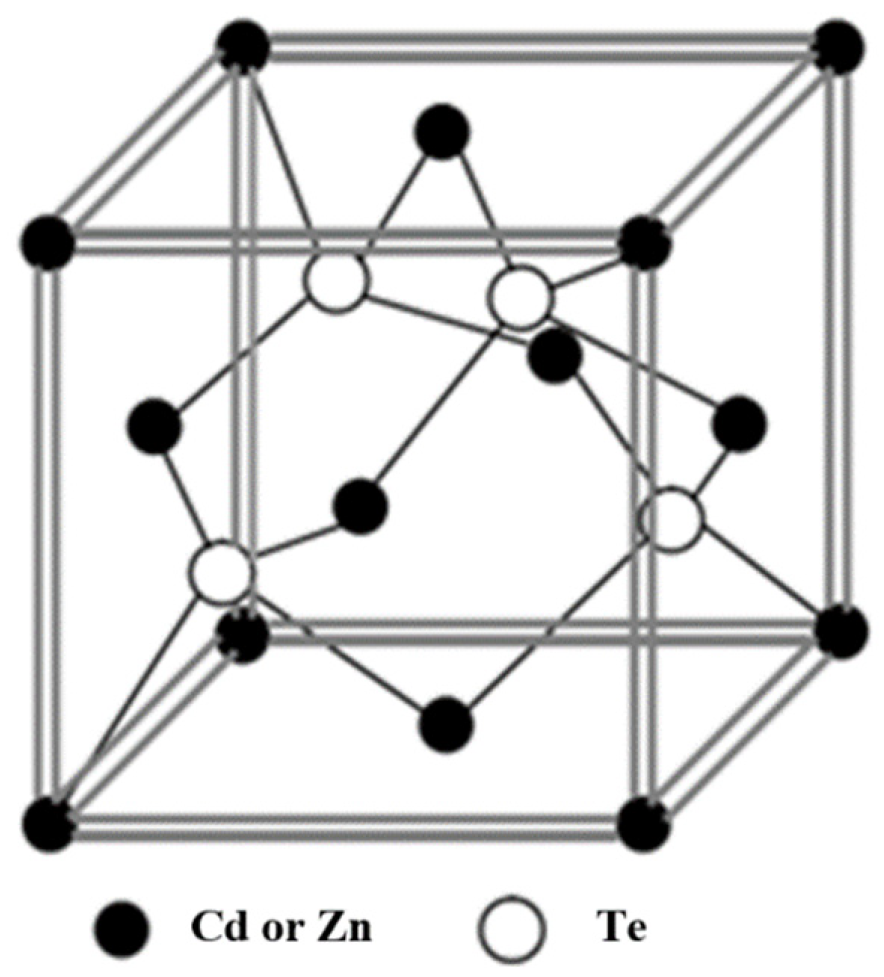
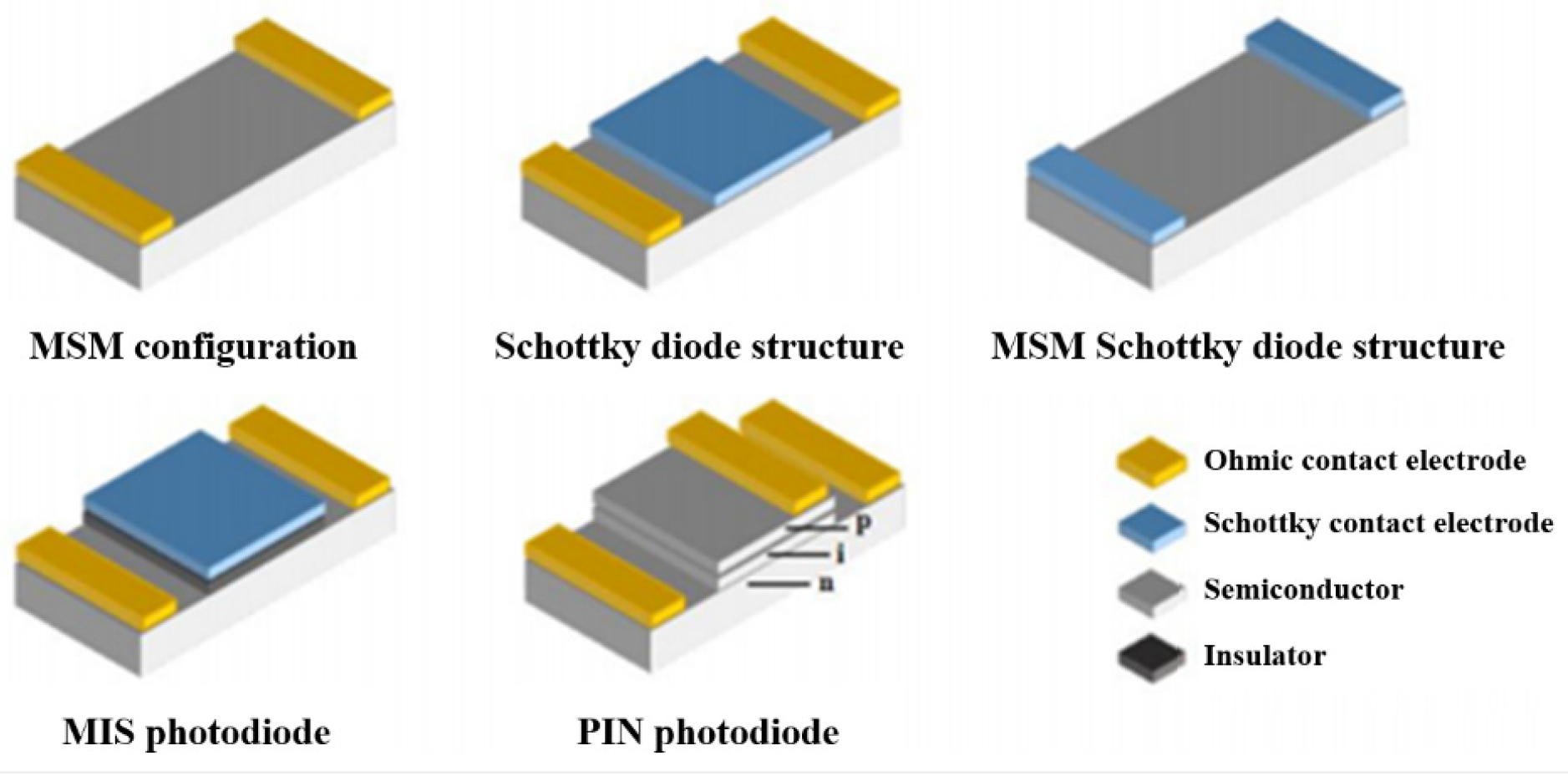
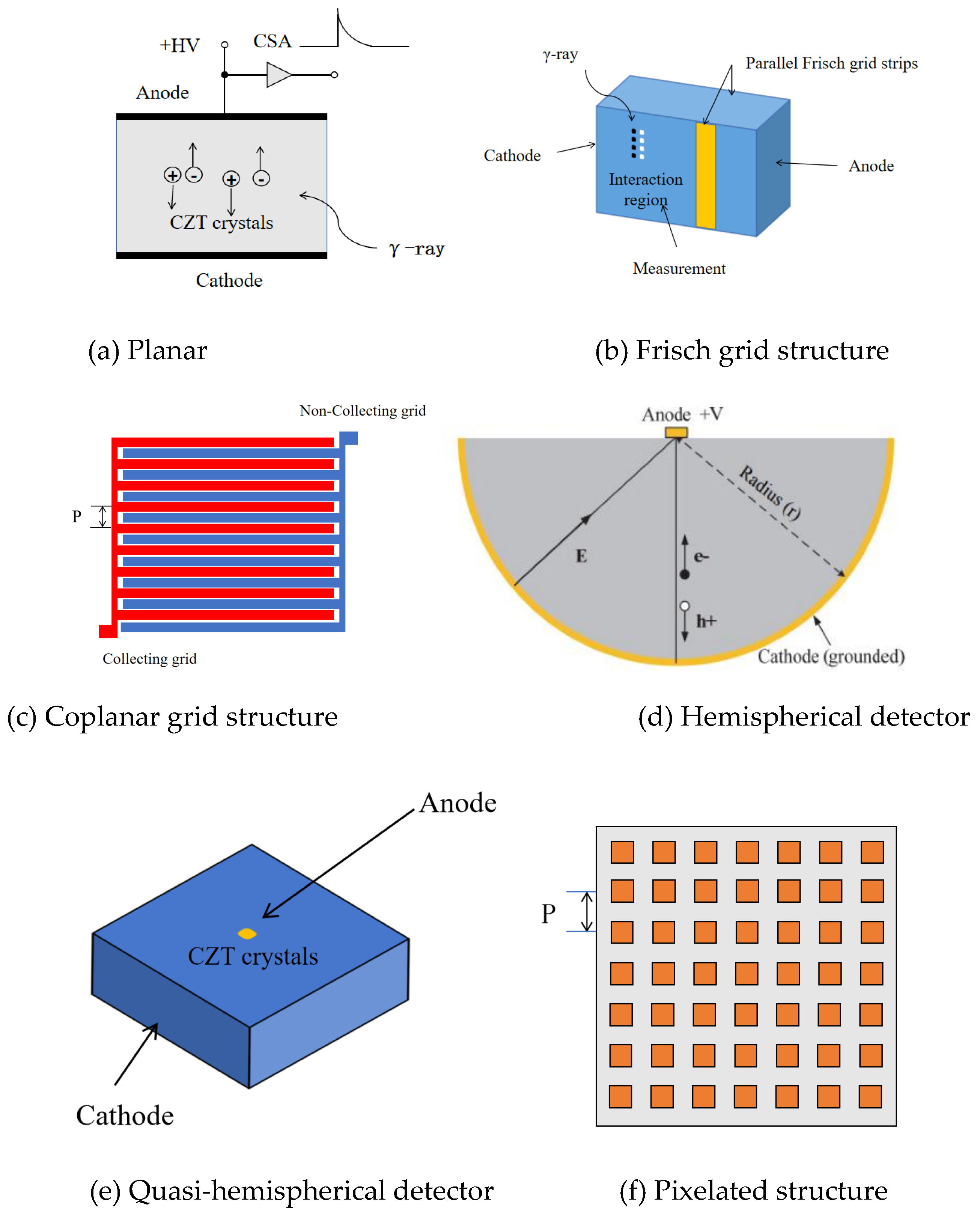
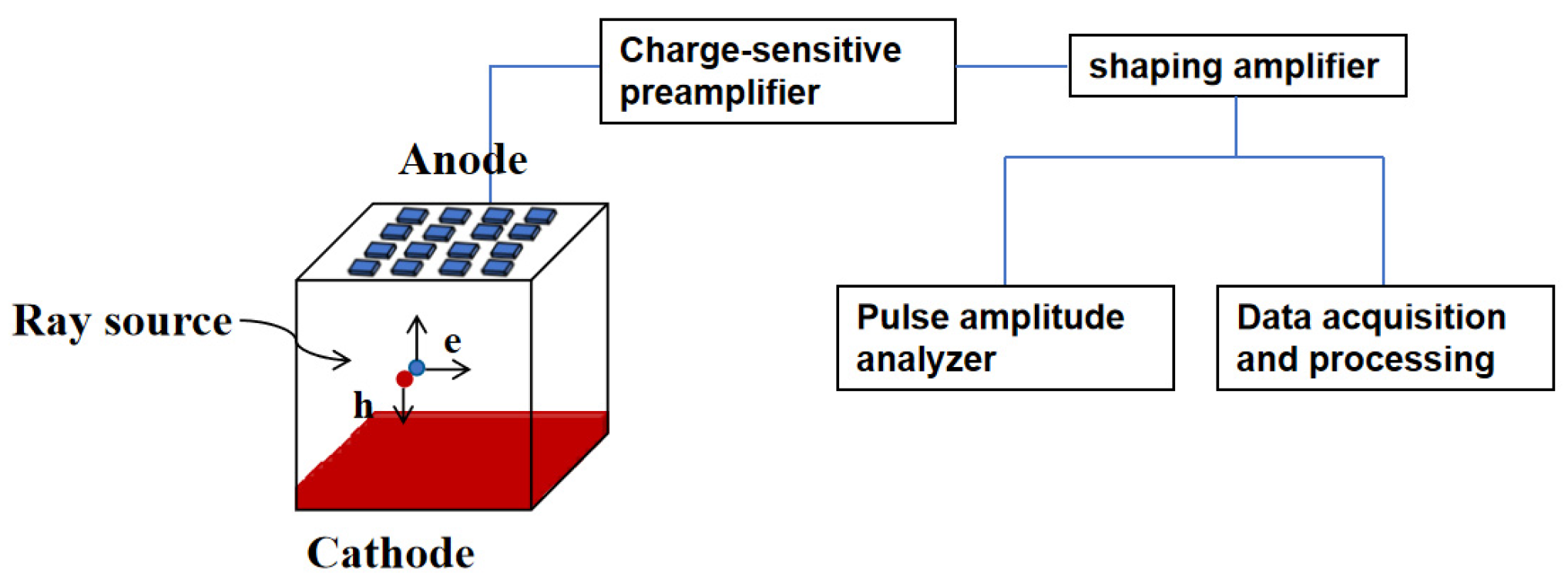
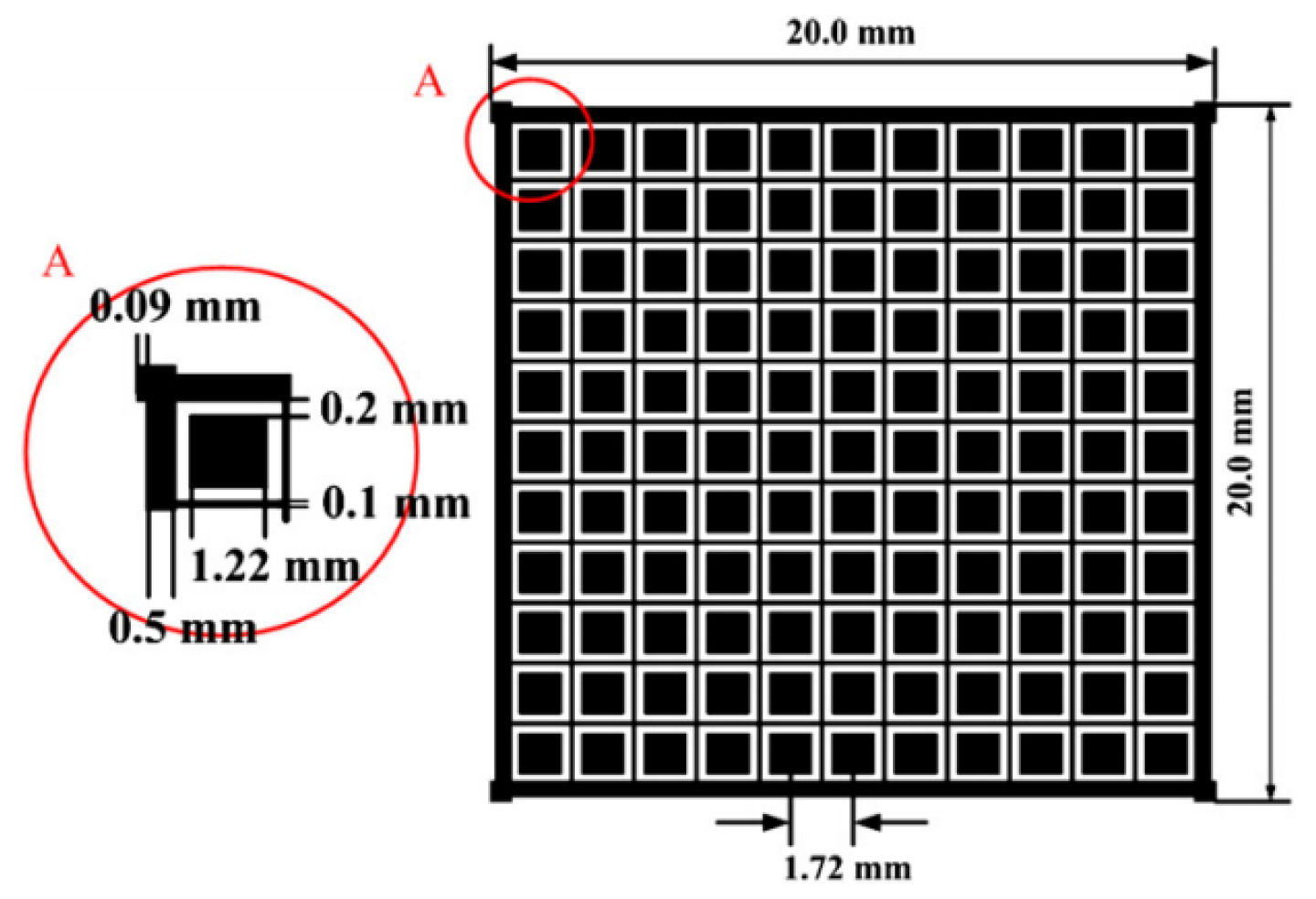
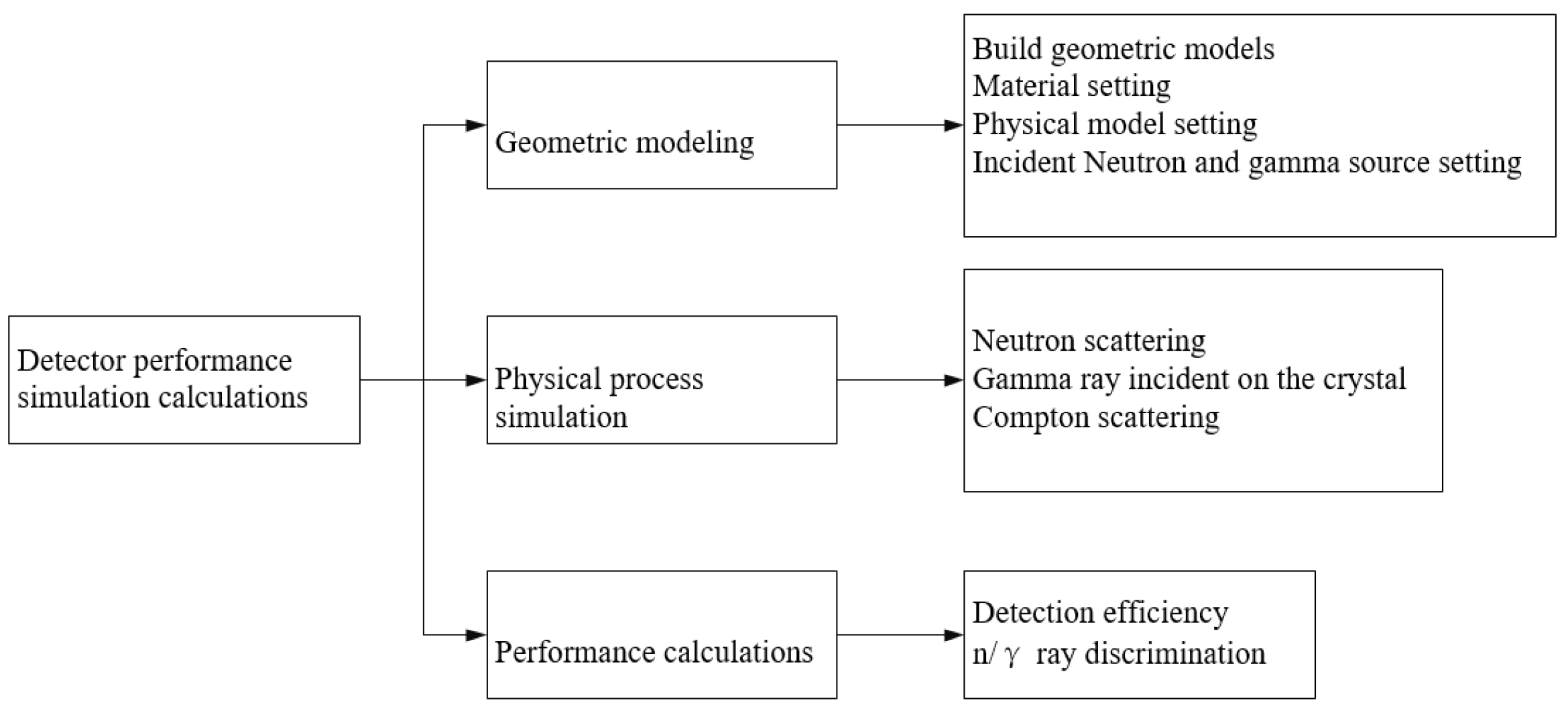
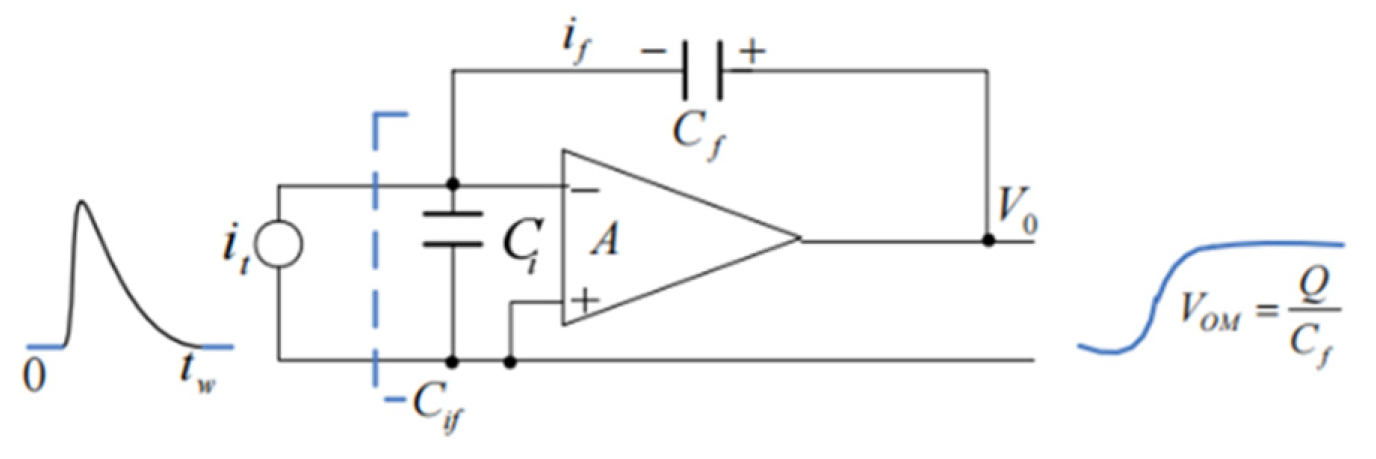
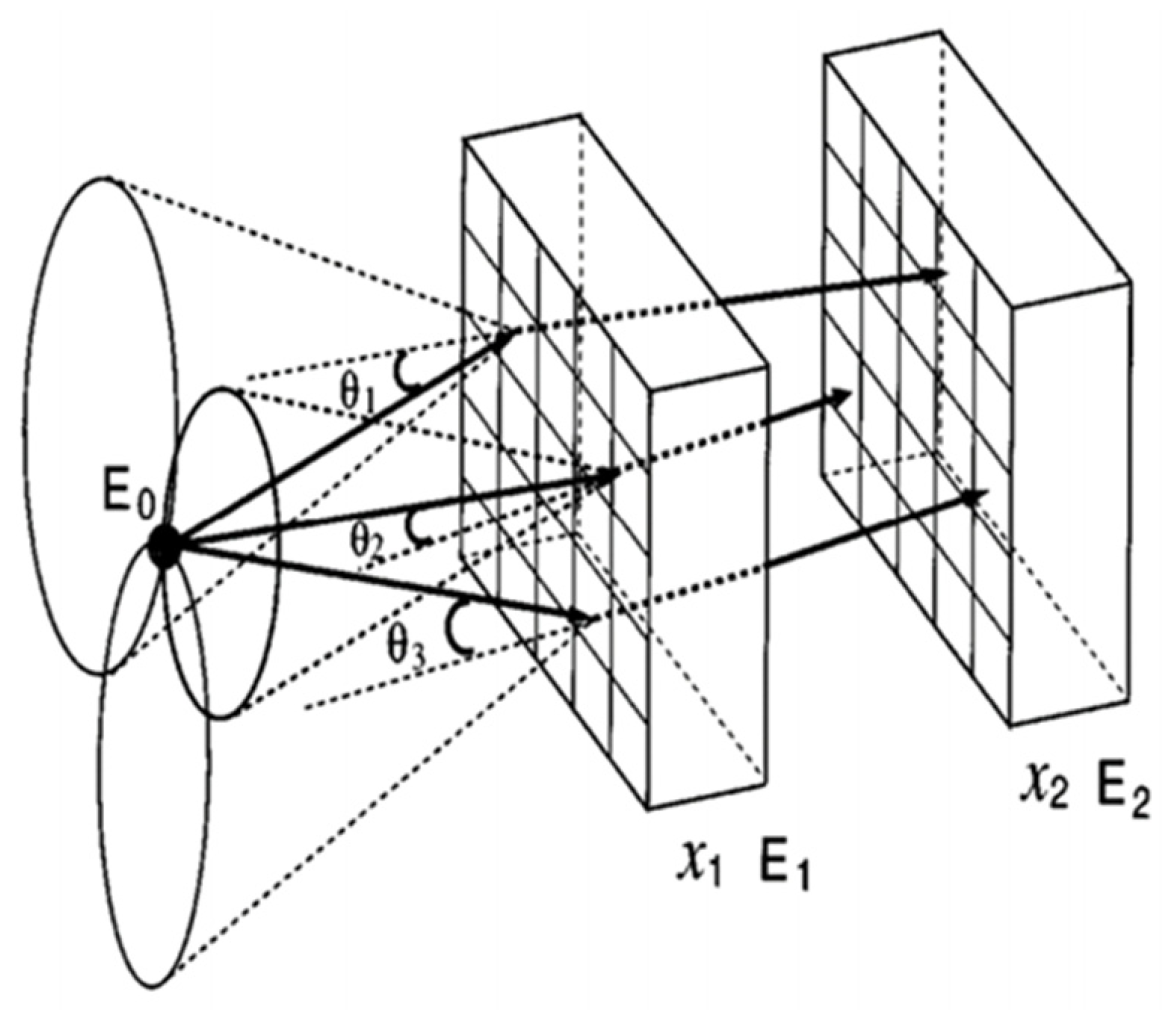
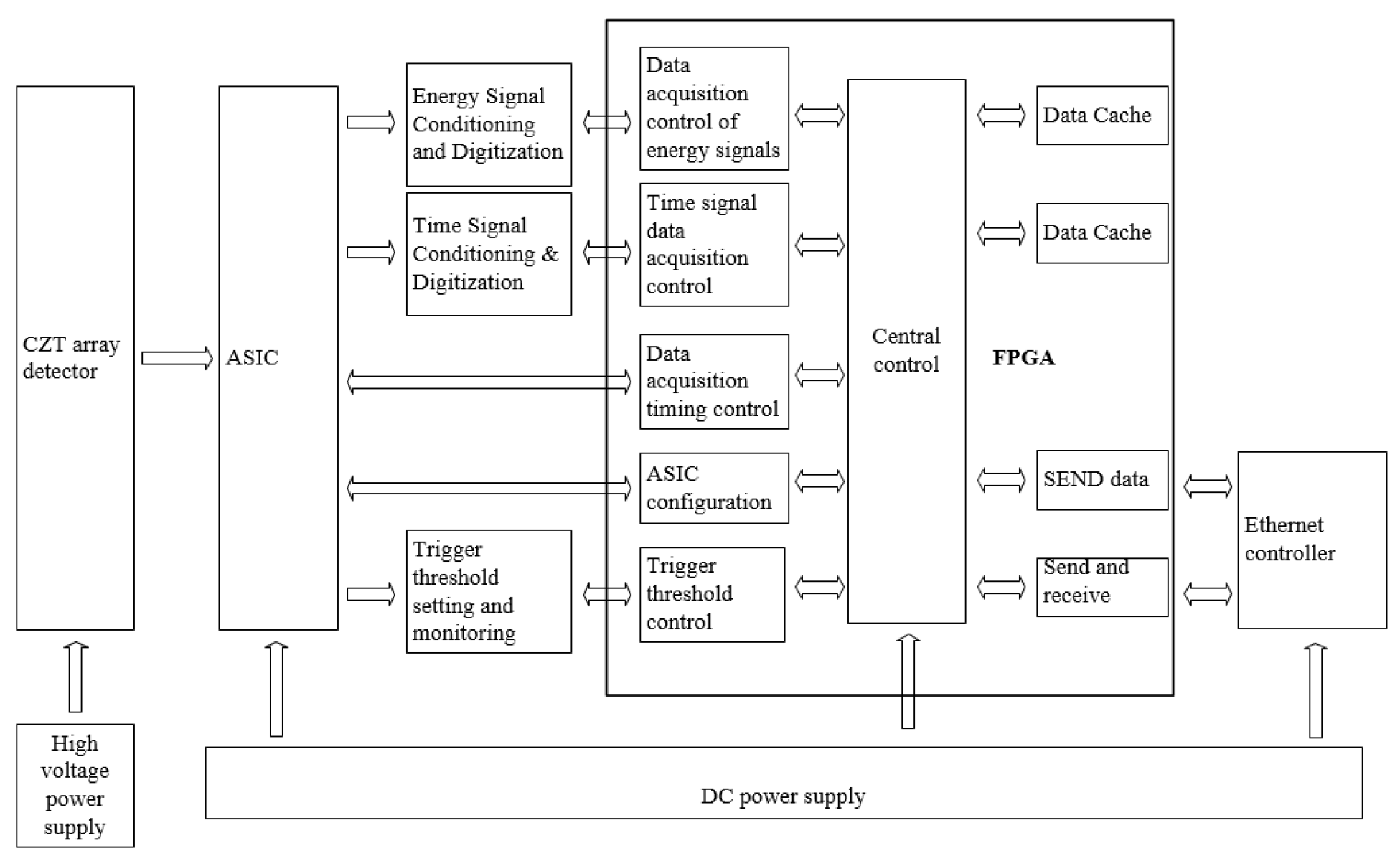
| Material | Atomic number | Density (g/cm3) | Bandgap width (eV) | Ionization energy (eV) | Resistivity | μeτe | μhτh |
| Si | 14 | 2.33 | 1.12 | 3.62 | 104 | >1 | 1 |
| Ge | 32 | 5.33 | 0.67 | 2.96 | 50 | >1 | >1 |
| InP | 15/49 | 4.78 | 1.35 | 4.2 | 106 | 5×10-6 | <2×10-5 |
| GaAs | 33/31 | 5.32 | 1.43 | 4.2 | 107 | 10-5 | 10-6 |
| HgI2 | 80/53 | 6.40 | 2.13 | 4.2 | 1013 | 10-4 | 10-5 |
| PbI2 | 82/53 | 6.20 | 2.3~2.6 | 4.9 | 1012 | 10-6 | 10-7 |
| TlBr | 81/35 | 7.56 | 2.68 | 6.5 | 1012 | 10-5 | 10-6 |
| CdTe | 48/52 | 6.20 | 1.44 | 4.43 | 109 | 10-3 | 10-4 |
| Cd0.9Zn0.1Te | 48/30/52 | 5.78 | 1.57 | 4.64 | 1010~1011 | 10-3~10-2 | 10-5 |
| Cd0.8Zn0.2Te | 48/3052 | 6.02 | 1.5~2.2 | 5.0 | 1010~1011 | 10-3 | 10-6~10-5 |
Disclaimer/Publisher’s Note: The statements, opinions and data contained in all publications are solely those of the individual author(s) and contributor(s) and not of MDPI and/or the editor(s). MDPI and/or the editor(s) disclaim responsibility for any injury to people or property resulting from any ideas, methods, instructions or products referred to in the content. |
© 2023 by the authors. Licensee MDPI, Basel, Switzerland. This article is an open access article distributed under the terms and conditions of the Creative Commons Attribution (CC BY) license (http://creativecommons.org/licenses/by/4.0/).





